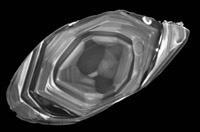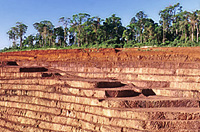
"There's no bismuth like show bismuth" *
In which John explores further all those tangents that divert him in his lectures ...
* This book is dedicated to people who pick up rocks and stop to think
Dedication in "Nuclear Geology" (1954), edited by H.H. Faul. A fine old book from the early days of geochronology, written as the subject was beginning the move from the world of physics into a few pioneering geochemistry labs. It is rumored (though I can't confirm it) that an error in the first print run led to the first few copies being mis-titled "Unclear Geology".
No bismuth like show bismuth ...
With apologies to Matt Groening and David X Cohen, this one is swiped from the opening credits to Futurama, season 7, episode 10. "Let's boldly go where we've gone before!"List three interesting things about Bismuth: (1) It's the heaviest stable element, with A = 209. (2) Tragically, it has only one stable isotope. (3) Like water and its solid form, ice, metallic bismuth expands on freezing.
Everyone wants a Chart of the Nuclides, right? You can buy one, either as a big colorful poster (impress your dorm friends ...) or a handy reference book. Either version costs $25.00 from chartofthenuclides.com. Of course there are free, interactive versions on the web. The best two that I've come across are from: the Korean Atomic Energy Research Institute (KAERI) and Brookhaven National Lab. For the Brookhaven chart you need to zoom in to level 1 to see the familiar isotopic abundances, decay modes, etc.* Urban Pb, forensic geochemistry
You should read Bill Bryson's book "A Short History of Nearly Everything". In between explaining the cosmos in simple terms, he describes the work of Caltech geochemist Clair Patterson, who: (i) Wrote the best geochronology paper ever, and (ii) Campaigned for removal of the gasoline additive tetraethyl Pb after finding Pb contamination spread throughout the modern world, including throughout modern humans.
After you finish reading Clair Patterson's paper on the age of meteorites and the Earth, you might also like to look at another classic of geochemistry: The terrestrial economy of helium and argon by Karl Turekian. Published in 1959, it sets out the basics of how we've looked at planetary degassing ever since, and makes good background reading for Lab 5.
How to write a scientific abstract ...
From Sam Epstein's 1951 paper which launched the field of stable isotope paleo-thermometry:
"A relationship between temperature and relative O18 abundance in calcium carbonate in marine shells has been determined. If the relative O18 abundance of the water in which the shell grew is known, the temperature can be determined to an accuracy of ±1.0°C. The relative O18 contents of marine waters increase with salinity and, in the case of surface marine waters, with salinity and temperature."
(Of course it helps to start by doing science of this significance)



